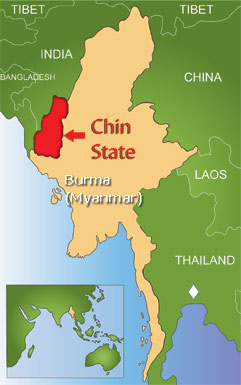Tensions as Burma’s Junta Increases Military Mobilization in Ethnic Areas

25 February 2011: Within just more than three weeks of convening its new Parliament, the military-turned-civilian government of Burma steps up its military presence in some parts of ethnic areas while still launching brutal attacks in others, instead of making attempts to bring national reconciliation and peace into the country.
The lastest movement of Burma’s regime in its military build-up and mobilization in ethnic areas has increased tensions among ethnic armed groups, signalling a possible outbreak of civil war in the country, according to sources.
In Kachin State early this week, several tanks, trucks and troops of Burma Army have been transferred into the outskirts of Waingmaw Town near Laiza, General Headquarters of Kachin Independence Organisation (KIO), according to the Kachin News.
About 100 Kachin youths have fled into the KIO military base following forced military conscription by the junta’s Northern Command in Kachin State since 17 February 2011.
On 7 February this year, there was an open-fire clash between Mohnyin-based Burma Army Infantry Battallion No. 15 and Kachin Independence Army’s battalion 27 in Manwin Township.
In Shan State, the military authorities have closed the roads leading to Wanhai of Kehsi Township since 20 February 2011 where an anti-Border Guard Force armed group, Shan State Army (SSA-North), stations .
The move has been claimed as an immediate reaction to SSA-North’s participating in the recent formation of UNFC (United Nationalities Federal Council), an alliance of ethnic armed ceasefire and non-ceasefire groups.
Burma Army has attacked the Shan State Army (North) four times since last year, according to the Shanland News.
Last Tuesday, three Burmese soldiers were killed in a clash with Shan State Army (SSA-South) near Mongton Township in southern Shan State, said the Irrawaddy.
In Chin State, a Burmese soldier from Light Infantry No. 55 based in Sinletwa village camp last week was killed and another injured in a skirmish with troops from Chin National Army (CNA) in Paletwa Township near the Indo-Burma border.
In a statement issued yesterday, the Karen National Union (KNU) rejected the baseless accusation made by Burma’s military junta over opening fire at a farm in Shwegyin Township of Bago Division on 17 February leaving four workers dead and three wounded, saying: “It is just a smoke screen for the military dictatorship to build up an offensive against KNU and KNLA (Karen National Liberation Army).”
Vice-Chairman of the New Mon State Party (NMSP), Nai Rot Sa, said in his address at the 64th Mon National Day commemoration on 19 February 2011: “The regime want us to surrrender our arms to them. We will never do it. We will join our people and fight for freedom with these arms.”
Late last month, Karenni Army joined with the Karen National Liberation Army in saving local villagers who were forced by Burma Army soldiers to carry rations and other commodoties near Peh Htar area of Pa Saung Township in Karenni State.
On 30 January 2011, just one day before the new Parliament was convened in Naypyidaw, a fight between Burma Army and the 5th Brigade of the Democratic Karen Buddhist Army (DKBA) on the Thai-Burma border forced thousands of villagers into hiding near Moei river.
For decades, Burma’s ethnic nationalities, which make up more than 40 percent of the whole population and take up 60 percent of the territory, have fought for freedom, equal rights, self-determination and democratic federalism of government.
Recently, two alliances of ethnic political and armed groups, CEFU (Committee for Emergence of a Federal Union) and UNFC (United Nationalities Federal Council) were established along the Thai-Burma border, calling for the formation of a genuine federal union of Burma.
Van Biak Thang
[email protected]






